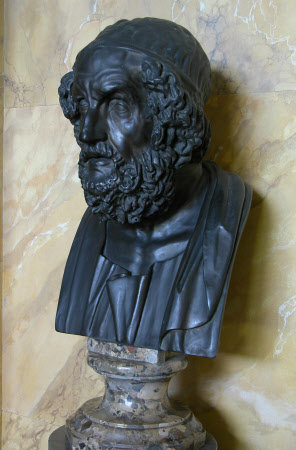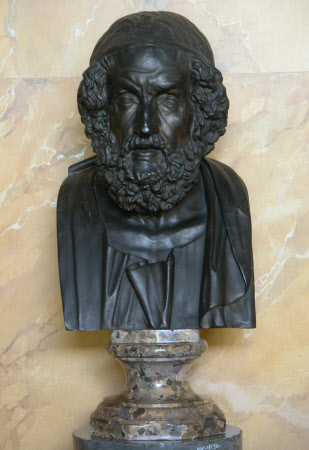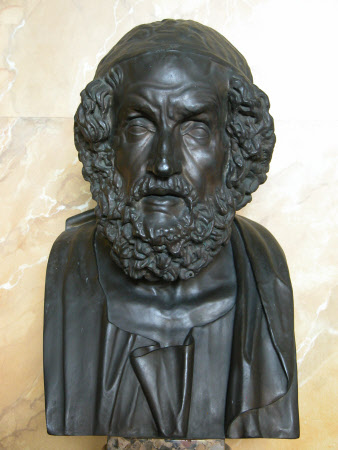Portrait bust of the poet Homer
Sabatino de Angelis (b.1838)
Category
Art / Sculpture
Date
1889
Materials
Bronze and marble
Measurements
535 mm (H); 305 mm (W)
Place of origin
Naples
Order this imageCollection
Hatchlands Park, Surrey
NT 1166749
Summary
Sculpture, bronze; bust of the Greek poet Homer; Naples, foundry of Sabatino De Angelis (1838- c. 1915); 1889. A bronze bust of the ancient Greek poet Homer, based on a marble bust in the Museo Archeologico Nazionale in Naples, formerly in the Farnese collection in Rome. It was cast by Sabatino de Angelis, one of a number of Neapolitan sculptors in the later nineteenth and early twentieth centuries, who set up bronze foundries to meet the demand for copies of famous antiquities, especially but not just those that had been discovered in Pompeii and Herculaneum. The group of five major bronze casts at Hatchlands is an impressive representative example of the fashion for collecting these copies of antiquities in the decades around 1900.De Angelis was widely regarded as the finest among the Neapolitan bronze founders working at this time.
Full description
A bronze portrait bust of Homer, depicting the Greek poet, author of the Iliad and the Odyssey, heavily bearded and with a headband (mitra) across his forehead, facing to his front. His brows are furrowed and his eyes slightly pursed, reminding the viewer that Homer is reputed to have been blind. Dressed in a loose chiton tunic, the bust squared, and mounted on a variegated marble socle. It is signed and dated on the edge of the bust section at back. The original marble bust on which this bronze example is based is today in the collections of the Museo Archeologico Nazionale in Naples (Inv. 6023; Naples 1989, no. 20), but was formerly in the Farnese collection. First recorded in the late seventeenth century in the Palazzo Farnese in Rome, the bust was taken to Naples in the late eighteenth century. The marble was heavily restored whilst in Rome, the main additions being the nose and the whole bust section below the neck. The Farnese Homer is one of a significant number of copies to have survived of a lost late Hellenistic original. Homer’s very existence is uncertain so, by definition, no genuine portraits of the poet exist. But this Hellenistic depiction effectively captures aspects of his appearance as described in many ancient sources, a venerable man, afflicted by blindness, his furrowed brow suggesting his constant search for poetical inspiration. The bronze was cast by Sabatino de Angelis (1838–c. 1915), whose foundry was established in 1840, presumably by his father. It became, along with the Chiurazzi and Giorgio Sommer, one of the most successful and best-known of the Neapolitan foundries, which capitalised on the international demand for high-quality copies of antiquities from Herculaneum, Pompeii, Rome and elsewhere, that grew exponentially after the Italian government had in 1860 agreed to allow the making of copies of objects in the museum in Naples. All three foundries published catalogues of the products they offered, the 1900 catalogue from Sabatino de Angelis proudly proclaiming on its cover that the firm supplied casts to various European royal houses, as well as leading museums in London, Edinburgh, Glasgow, Boston, Chicago, New York and elsewhere. In the 1870s, Sabatino de Angelis also entered into a joint venture with the rival Chiurazzi foundry, forming the Fonderie Artistiche Riunite, the main purpose of which was to cater for the burgeoning American market. It also published a catalogue in 1910, largely based on the 1900 de Angelis catalogue, suggesting that it was this foundry that provided the majority of the models for the joint venture. It certainly appears to be the case that de Angelis was especially highly regarded internationally, the American curator Edward Robinson writing in 1892 that Sabatino De Angelis was ‘by far the best of the numerous Neapolitan copyists, his talent and feeling for his line of work being rare in any generation.’ (Edward Robinson, ‘Casts for the Metropolitan Museum of New York’, American Architect and Building News, 37 no. 872, 10 September 1892, pp. 166-68, p. 167). In both the 1900 and 1910 catalogues, the bust was described ‘the most beautiful bust known’ (‘le plus beau buste connu’). Like most of the models offered by de Angelis and Chiurazzi, casts could be bought in different sizes, the same as the original bust, 56 cms. high, or in smaller versions modelled in the factory, in this case 30 and 26 cms. high. It was available in two patinations, a dark-brown described as ‘Herculaneum’ or a richer and brighter colour, described in the company’s catalogues as ‘moderne’. The Hatchlands version is probably the latter. The five impressive casts at Hatchlands were probably all acquired by Harry Goodhart-Rendell’s grandfather Stuart Rendel, 1st Baron Rendel (1834-1913) to furnish the entrance hall at Hatchlands, after he had bought the house in 1888. Jeremy Warren May 2023
Provenance
Presumably acquired by Stuart Rendel, 1st Baron Rendel (1834-1913), c. 1890; by descent to Harry Stuart Goodhart-Rendel (1887-1959), by whom given in 1958.
Marks and inscriptions
Back of bust, edge:: Sabatino 1889 / Napoli
Makers and roles
Sabatino de Angelis (b.1838) , caster
References
Sabatino 1900: Catalogue illustré de Sab. De Angelis et fils, Naples, Naples 1900, p. 90, no. 6023 Chiurazzi and De Angelis 1910: Fonderie Artistiche Riunite. J. Chiurazzi & Fils – S. De Angelis & Fils. Bronzes, Marbres, Argenterie, Naples 1910, p. 34, no. 6023. Naples 1989: Renata Cantilena et al., Le Collezioni del Museo Nazionale di Napoli, 2 vols., Rome 1989, II, pp. 156-57, no. 20


